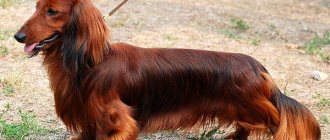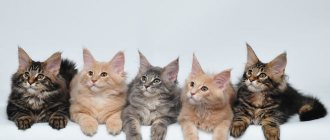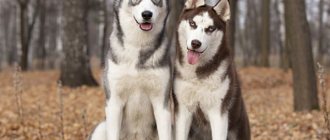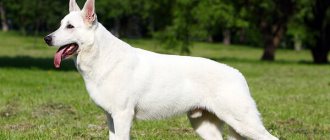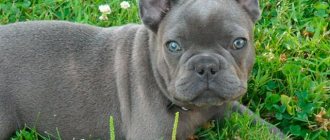The pug dog breed is one of the most mysterious in the world. Its origins go back centuries. The first mentions of this breed are found in the chronicles of China.
These decorative dogs were bred specifically for Chinese emperors and nobility. A servant was assigned to the dogs, who made sure that the animal was comfortable and cozy. The servant was also responsible for the health of the pet. A special collar with a bell was placed around the neck.
The Pug is an extremely friendly breed of dog. They become strongly attached to family members. Able to adapt to the owner's lifestyle.
But, do not forget that this breed is slightly lazy. Despite this, the dog will never refuse to play. Pug puppies in particular are quite active.
What color are pugs born?
When a pug baby is born, it can be any color: beige, gray, brown, etc. But the fact is that:
- the initial color of the fur is not an indicator of what it will be like in a year or two;
- On average, up to one and a half years, the color of a pug’s coat can change dramatically, that is, it can both lighten and darken.
But it is reliably known that a black pug always gives birth to a black puppy (regardless of which of the parents is black and what shade the second dog is).
Standard
At competitions you can most often find light-colored pugs. The following parameters are considered exhibition classics:
- Having a mask around the nose and eyes.
- Black nose, nose and lip contour.
- Black, neat claws.
- Dark brown, almost black eyes. The whites of the eyes should not be visible.
- The coat is dense, short, thick, with a very fluffy and pleasant to the touch undercoat.
As for black pugs, their coat should be pure black, without impurities. It is acceptable to have a small light mark on the chest, however, this is a minus. The same goes for dogs with chocolate coat color.
Peach ones are quite rare, so they show special interest at the exhibition, paying attention to the presence of points and marks.
Important! Regardless of coat color, pugs shed a lot. Therefore, comb them out as often as possible with a brush-mitten. This will keep your hair healthy and prevent the appearance of unhealthy yellowness.
And also, given the fact that pugs shed very often, it is worth understanding that the color of a puppy’s coat is not the final option. There is a high probability that some noticeable spots may “resolve” as the animal grows, or after the first moult the light skin will become much darker and richer.
Which puppy to choose?
If you are choosing a future pet of a non-standard color, and even more so if you plan to connect its future with exhibitions, carefully read its pedigree and the pedigrees of each of its parents. This is quite entertaining and gives a general idea of what dogs need to be crossed to get this or that color.
Be sure to look at photos of puppies from previous litters, ask breeders about the characteristic features of color - how they shed, whether they fade in the sun, whether they darken.
A conscientious breeder will answer all your questions in detail, and also advise the diet necessary to maintain the health and beauty of the pet.
What colors are pugs?
Pugs come in a variety of colors. Some colors are more common, others less common. The colors of pugs and their names are further in the article.
White
Do not confuse a white pug with an albino. In the first case, the dog still has a dark face and dark eyes. The coat of a light pug can have a shade from snow-white to a more pronounced and delicate milky color. And albino pets have light eyes and a completely pink muzzle.
Cream
The color resembles a mixture of white and beige. Pugs with creamy fur combined with a dark muzzle look airy and gentle.
Black
A rare wool color that became popular thanks to the British. In the homeland of pugs, China, charcoal coloring was perceived as a defect. In England, on the contrary, these small coals were in great demand. The black fur resembles velvet. Not only by touch, but also by its shimmer in the sun.
Black and white
Typically, a black and white pug refers to a charcoal dog with white spots on its fur. This color option is rare.
Ginger
The red-haired pug has rich fur. This color is a relative of peach, but with increased brightness and depth of color. Like black, red colors are rare.
Gray (ash)
This is a subtype of silver color. Gray wool looks lighter and more faded. If you look at a gray pet from a close distance, you will notice a characteristic metallic tint on its fur coat. Because of this ebb, the “gray” effect is created.
Apricot
Apricot-colored pugs are also called sunny fawns. The apricot pet has a coat of a faint beige shade with a slight bias toward yellow. It will be difficult for an inexperienced person to distinguish the colors “apricot” from “peach”, because they are based on the same color.
The apricot shade of the fur appears only when the dog is one and a half years old.
Beige
“Faun” pugs (as they are called due to their beige coat) are common. Although the light color gene is recessive. Typically, “fauns” have a coarser coat, a soft undercoat, and always have dark brown eyes.
Chocolate (brown)
The chocolate-colored pug is evenly colored. This is a warm shade that makes the pet look like a bear cub. The dogs have chocolate-colored not only the body, but also the entire face. Including the nose, although other pugs have it black. The chocolate fur coat goes especially beautifully with large brown eyes.
brindle
A brindle pug is a rarity. Its body is evenly covered with symmetrical stripes. This makes the dog look like an unknown exotic animal. The base shade is usually dark brown or gray. And the stripes have a lighter shade.
Despite their unusual appearance, tiger representatives cannot participate in exhibitions.
Silver
“Moon fawns” is the name given to silver-colored pugs. In fact, the “lunar” representatives are the owners of a beige fur coat, but when you look at them, a visual effect is created, as if the light of the Moon is falling on your pet. The shimmer resembles the shine of metal.
The silver color is not recognized by the breed club in Russia, but in Europe and America it is highly valued.
Marble
This is an unusual type of coloring, otherwise called "merle". Marble pets are characterized by a dark coat with randomly scattered light spots. Moreover, they are located on the surface of the entire body, including on the paws and muzzle. Among pugs, the merle type is very rare.
Peach
“Peaches” strongly resemble an apricot pet, but peach-colored pugs have a bright red color that is noticeable to the naked eye. Peach coloring is one of the rare ones, therefore it is valued on the same level as charcoal.
Pale yellow
Fawn-colored dogs are similar to the standard beige representative of the breed, only the “mask” on the head is not black, but brown, as if slightly faded in the sun.
Spotted
Spotted, like brindle representatives of the breed are considered “defective”, that is, they cannot participate in exhibitions. The size of a dog’s spots is different, and so is their location. As a rule, the base color shade is dark, and the spots are light.
Description of the breed
The pug has been a decorative dog breed since ancient times. It is generally accepted that she is a companion for humans. This breed has a stable psyche, good memory, and also has intelligence.
A small dog, but has well-developed muscles. The muzzle is slightly flattened, the head is round, and the nose is small. The pug's eyes are bulging and its ears are small.
Pugs have a wide neck, which emphasizes their physical development. The tail is short, the tip is always bent into a ring. Pugs have elastic skin with a small fold.
There are no clear size standards; the dog’s height should not be higher than 30 cm, and its weight should not exceed 8 kg. Next, we suggest looking at a photo of a pug dog that is close to the required standards.The gait is predominantly springy and elegant, which expresses the whole personality of the breed.
What color puppy should I choose?
If you take a puppy for future participation in exhibitions, you should carefully study the entire pedigree of the baby. This will make it possible to predict what color the baby’s coat will be by the age of 1-1.5 years. Usually, conscientious breeders immediately provide buyers with information about the dog’s ancestors, including color.
If the pet’s future is not connected with a “career,” then you need to rely only on your own taste. The shade of the coat does not change the character and habits of the dog.
Rare species
Most often you can find pugs of the following colors:
- yellowish;
- silver;
- beige;
- black.
Reference! Peach-colored pugs are considered the most expensive and rare at the moment.
Other colors are much less common. As a rule, such puppies quickly find their owners, although they are sold much more expensive than their counterparts. Connoisseurs of non-standard beauty are not deterred even by the fact that some colors are considered “culled”, as is the case with brindle color.
As for the most unusual colors, albinos are one of them. These are pure white dogs. Over the entire period, dog handlers have recorded less than ten cases of the birth of such puppies.
Questions and answers
What color are pugs born?
When a pug baby is just born, it can be any color: beige, gray, brown, etc. However, the initial color of the fur is not an indicator of what it will be like in a year or two. On average, up to one and a half years, the color of a pug’s coat can change dramatically, that is, it can both lighten and darken.
Are there white pugs?
Yes, there are. However, do not confuse white coloring with albinism. In the first case, the dog still has a dark face and dark eyes. The coat of a white dog can have a shade from snow-white to a more pronounced and delicate milky color. And albino pets have light eyes and a completely pink muzzle.
Origin story
The Pug breed is quite ancient . The first mention of pugs dates back to the times of ancient China, where these dogs were favorites of emperors.
They were also bred by Tibetan monks; pugs were temple guards. It was from there that dogs were brought to Europe. Of all the breeds, pugs are the most mysterious; their appearance has been associated with various myths and legends.
Scientists today argue about their homeland.
Many say that the breed originated in the Far East, others think in Africa, and still others in Europe . Most are inclined to believe that they appeared in the East.
Pugs were mentioned in ancient Chinese manuscripts; there are even images of such dogs in jade and ceramic rosaries.
Pugs lived in the imperial palace and never left it; the dogs had a personal servant and a collar with a bell. This privileged position is explained by the fact that the supra-forehead folds resemble a Chinese character, which is why the folds on the pug’s forehead were called the imperial sign.
In China, there were two varieties of similar dogs, differing only in long hair, “Ha Pa” and “Lo Jie” . "Ha Pa" were long-haired. Most likely, the ancestors of pugs were “Lo Jie”, they looked like Pekingese, but had short hair.
In 1553, the pug came to France, then to the Netherlands, and from there the English king William of Orange brought them to England in 1689.
Empress Josephine, Napoleon's first wife, had a beloved pug named "Fortune".
Nowadays, many celebrities such as fashion designer Valentino and others keep pugs..
Recognized colors
Pug colors come in a variety of shades, some of which are valued much higher than others.
Fawn
Brown or beige-brown wool. The standard, most common color of the breed.
Apricot (apricot)
Beige color with hints of apricot. It is also called sunlight fawn, which means “fawn in the sunlight.”

